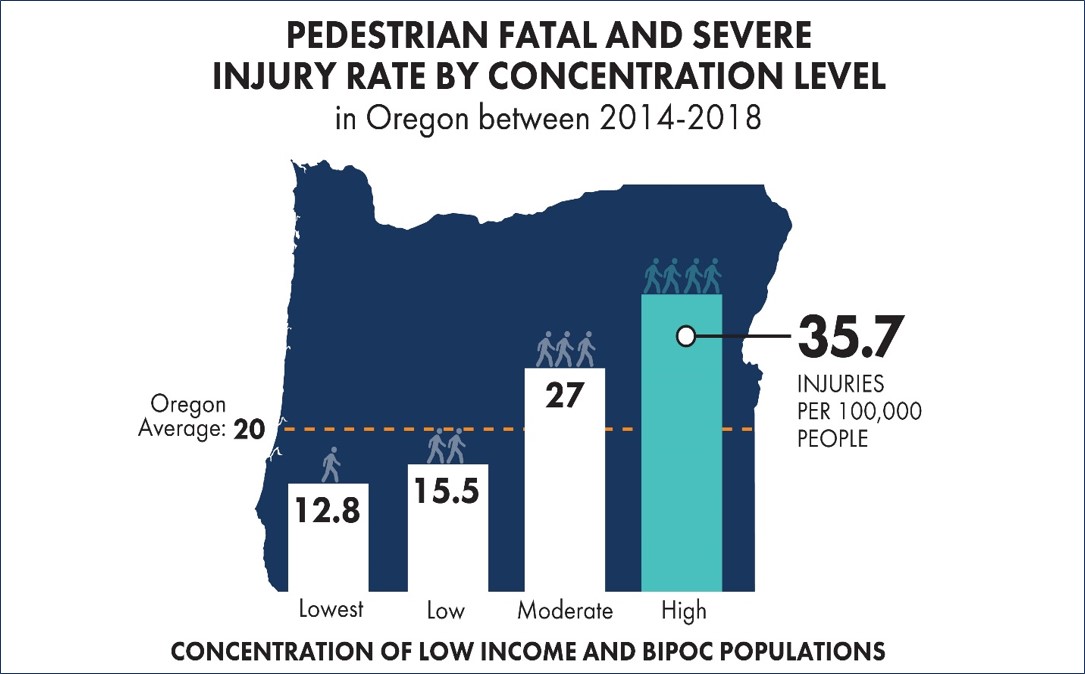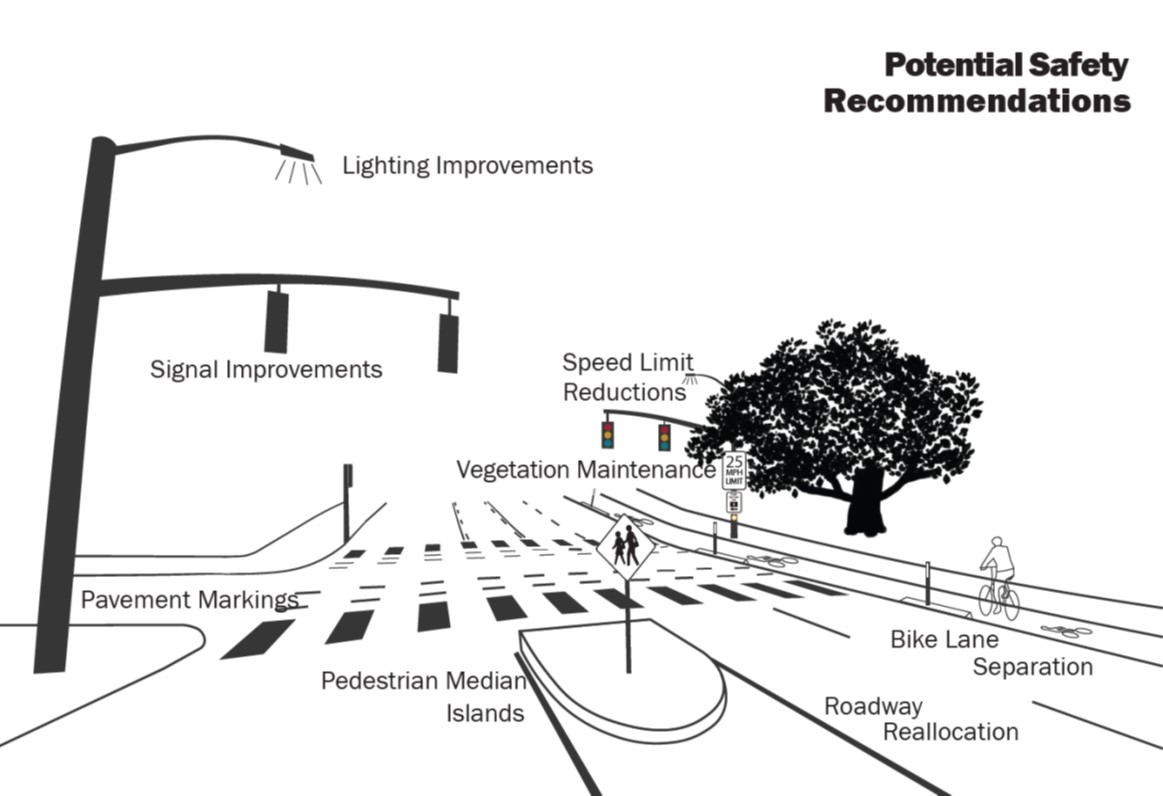Severe crashes involving people walking and bicycling are happening too often, and they are disproportionally located in low-income and BIPOC communities. The Equitable Active Safety Improvement Evaluation aims to reduce the frequency and severity of crashes involving people walking and bicycling and will prioritize social equity in its solutions on the state transportation system.
In fall 2021, ODOT initiated an effort to identify ways to more rapidly review, assess and deliver infrastructure safety improvements to address pedestrian and bicycle fatalities and serious injuries on the state highway system, particularly in low-income and BIPOC communities. ODOT recognizex that people walking or rolling on our highway system are disproportionately experiencing negative impacts compared to those in single occupancy vehicles. These outcomes are even worse for low income and BIPOC community members.
This initiative evaluated existing ODOT bicycle and pedestrian safety programs and the data guiding the agency. It also identified a suite of recommendations for improving existing programs and developing a new program in order to more consistently review, assess and make rapidly implementable improvements to the system. The assessment evaluated a range of funding options and potential tradeoffs that come with re-allocating existing program funds.
Input from the
Oregon Bicycle and Pedestrian Advisory Committee (OBPAC) informed ODOT’s recommendation to create a new, dedicated program to assess immediate safety incidents and implement changes and the re-allocation of state safety funds.

Crashes involving people walking and bicycling accounted for 13% of the total fatal and serious injury crashes statewide between 2016 and 2020. That number is trending upward based on preliminary data for 2021 and 2022.
A recent ODOT study, Understanding Pedestrian Injuries and Social Equity (2021), found that a disproportionate number of active transportation fatalities occur in low-income and BIPOC communities in Oregon. A number of contributing factors such as increased exposure, poor lighting, and prevalent bicycle and pedestrian crash risk factors are more likely to exist on roads through these communities.
Lag time from project concept to implementation is tremendous. Safety projects are typically identified 2-3 years before STIP creation. Then it takes 1-3 years before projects are constructed after the STIP is adopted. This limits ODOT’s ability to quickly respond to emerging active-transportation safety issues through most of its safety programs.
Crash data publication has a lengthy timeline and contributes to the lag between project programming and recent crashes. ODOT program managers are provided crash data in geo-referenced form 2-3 years after a crash has occurred. Long timelines for recent data create obstacles in project programming for safety projects
Solutions for active transportation safety can vary widely in terms of cost and time to construct. The recent initiative developed a playbook defining which countermeasures can be designed and constructed in a short time frame.
There is no consistent process for assessing and responding to fatal and serious pedestrian and bicycle crashes. This can result in locations with high needs to be ignored or assessed haphazardly.
Oregon Daily Traffic Toll Report
|
End Date Report: 12/21/2022
| Current Year
| Previous Year
| Percent Change
|
| 12/21/2022
| 12/21/2021
|
|
Year to Date |
Total Fatalities to Date
| 559 | 584
| -4.3%
|
Total Fatal Crashes to Date
| 517
| 538
| -3.9%
|
-Pedestrian Fatalities to Date:
| 123
| 85
| 44.7% |
-Pedalcyclist Fatalities to Date:
| 11
| 19
| -42.1%
|
-Motorcyclist Fatalities to Date:
| 85
| 85
| 0.0%
|
Federal funding requirements often limit flexibility in terms of program adaption and rapid implementation. Following the FHWA/DOT peer review, state funds were identified as the primary funding type that would meet the evaluation goals. In response to ODOT’s state funding shortage, the agency is prioritizing limited state funds to better address equity and rapid implementation for the safety of people walking and biking.
PDF Final Report Memorandum
Equitable engagement process we've been undergoing
- The consultant recommendation from the evaluation was to utilize the existing ODOT Equitable Engagement Toolkit from Office of Social Equity. That tool is based off the IAP2 Spectrum of Public Participation. The evaluation primarily recommended outreach for rapid response projects to occur within the Inform and Consult realm.
What we've accomplished
- The evaluation hosted two FHWA/DOT peer review sessions where participants shared promising practices that advance equity, rapid active transportation implementation, and data.
- The consultant performed an evaluation of ODOT Active Transportation and Safety programs to determine how programs implement social equity, place an emphasis on active transportation, and implement projects quickly. This evaluation, combined with promising practices from the FHWA/DOT peer review, laid the framework for the program.
- The project also considered crash data practices. Because data is the forefront of many programming efforts, fast access to recent data is a desired outcome of the project. The crash data practices document lays out short-term and long-term outcomes for ODOT so that data can be provided to ODOT program managers in a pace that is on par with other state DOTs.
- The evaluation provided a list of countermeasures and program directions (or modifications) for the Executive Steering Team to consider when pursuing implementation for an ODOT Rapid Improvement program.
What we've learned, what we are implementing
- The evaluation provided a series of recommendations for both crash data practices and a future program effort for active transportation rapid implementation.
- Crash data practices have been shared with ODOT DMV and the ODOT CAR unit and ODOT is pursuing short-term recommendations. Long-term recommendations involve multiple agency partners (OSP, Oregon Legislature) and discussions are continuing so ODOT can achieve the goal of receiving faster crash data.
- We learned that ODOT is at the forefront of implementing equity in project programming and creating risk-based and asset-based active transportation data sets. Many state DOTs are still learning to implement these data sets.
- The project also provided some general recommendations for all ODOT programs to implement, such as better utilization of the ODOT Social Equity map early on in the programming phase.
What we are considering for the program
- ODOT and the consultant developed a list of countermeasures that serve as a toolkit for rapid active transportation implementation. These countermeasures typically do not involve extensive right of way purchases or environmental permitting and have attributed crash reduction factors (CRFs) from the ODOT All Roads Transportation Safety program.
- The consultant provided an initial methodology that would prioritize safety and equity for a data-driven process in the future program.
Incorporating feedback from OBPAC
- The project’s Executive Steering Committee is incorporating feedback from the OBPAC into a proposal to the OTC in 2023.

"Potential Safety Recommendations" illustrates improvements to lighting, signals, pavement markings, pedestrian median islands, speed limit reductions, vegetation maintenance, bike lane seperation, and roadway reallocations as countermeasure that are quickly implementable.